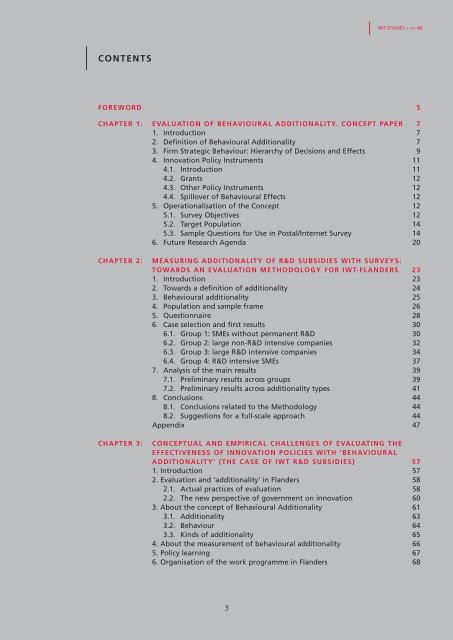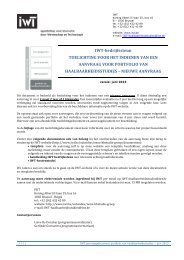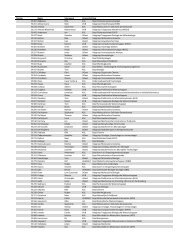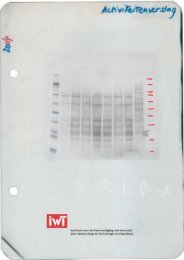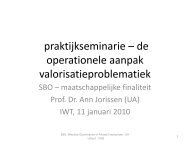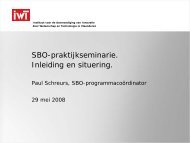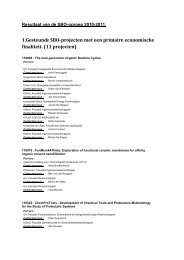The Evaluation of 'Behavioural Additionality' - IWT
The Evaluation of 'Behavioural Additionality' - IWT
The Evaluation of 'Behavioural Additionality' - IWT
You also want an ePaper? Increase the reach of your titles
YUMPU automatically turns print PDFs into web optimized ePapers that Google loves.
<strong>IWT</strong>-STUDIES > >> 48<br />
CONTENTS<br />
FOREWORD 5<br />
CHAPTER 1: EVALUATION OF BEHAVIOURAL ADDITIONALITY. CONCEPT PAPER 7<br />
1. Introduction 7<br />
2. Definition <strong>of</strong> Behavioural Additionality 7<br />
3. Firm Strategic Behaviour: Hierarchy <strong>of</strong> Decisions and Effects 9<br />
4. Innovation Policy Instruments 11<br />
4.1. Introduction 11<br />
4.2. Grants 12<br />
4.3. Other Policy Instruments 12<br />
4.4. Spillover <strong>of</strong> Behavioural Effects 12<br />
5. Operationalisation <strong>of</strong> the Concept 12<br />
5.1. Survey Objectives 12<br />
5.2. Target Population 14<br />
5.3. Sample Questions for Use in Postal/Internet Survey 14<br />
6. Future Research Agenda 20<br />
CHAPTER 2:<br />
CHAPTER 3:<br />
MEASURING ADDITIONALITY OF R&D SUBSIDIES WITH SURVEYS:<br />
TOWARDS AN EVALUATION METHODOLOGY FOR <strong>IWT</strong>-FLANDERS 23<br />
1. Introduction 23<br />
2. Towards a definition <strong>of</strong> additionality 24<br />
3. Behavioural additionality 25<br />
4. Population and sample frame 26<br />
5. Questionnaire 28<br />
6. Case selection and first results 30<br />
6.1. Group 1: SMEs without permanent R&D 30<br />
6.2. Group 2: large non-R&D intensive companies 32<br />
6.3. Group 3: large R&D intensive companies 34<br />
6.4. Group 4: R&D intensive SMEs 37<br />
7. Analysis <strong>of</strong> the main results 39<br />
7.1. Preliminary results across groups 39<br />
7.2. Preliminary results across additionality types 41<br />
8. Conclusions 44<br />
8.1. Conclusions related to the Methodology 44<br />
8.2. Suggestions for a full-scale approach 44<br />
Appendix 47<br />
CONCEPTUAL AND EMPIRICAL CHALLENGES OF EVALUATING THE<br />
EFFECTIVENESS OF INNOVATION POLICIES WITH ‘BEHAVIOURAL<br />
ADDITIONALITY’ (THE CASE OF <strong>IWT</strong> R&D SUBSIDIES) 57<br />
1. Introduction 57<br />
2. <strong>Evaluation</strong> and ‘additionality’ in Flanders 58<br />
2.1. Actual practices <strong>of</strong> evaluation 58<br />
2.2. <strong>The</strong> new perspective <strong>of</strong> government on innovation 60<br />
3. About the concept <strong>of</strong> Behavioural Additionality 61<br />
3.1. Additionality 63<br />
3.2. Behaviour 64<br />
3.3. Kinds <strong>of</strong> additionality 65<br />
4. About the measurement <strong>of</strong> behavioural additionality 66<br />
5. Policy learning 67<br />
6. Organisation <strong>of</strong> the work programme in Flanders 68<br />
3


